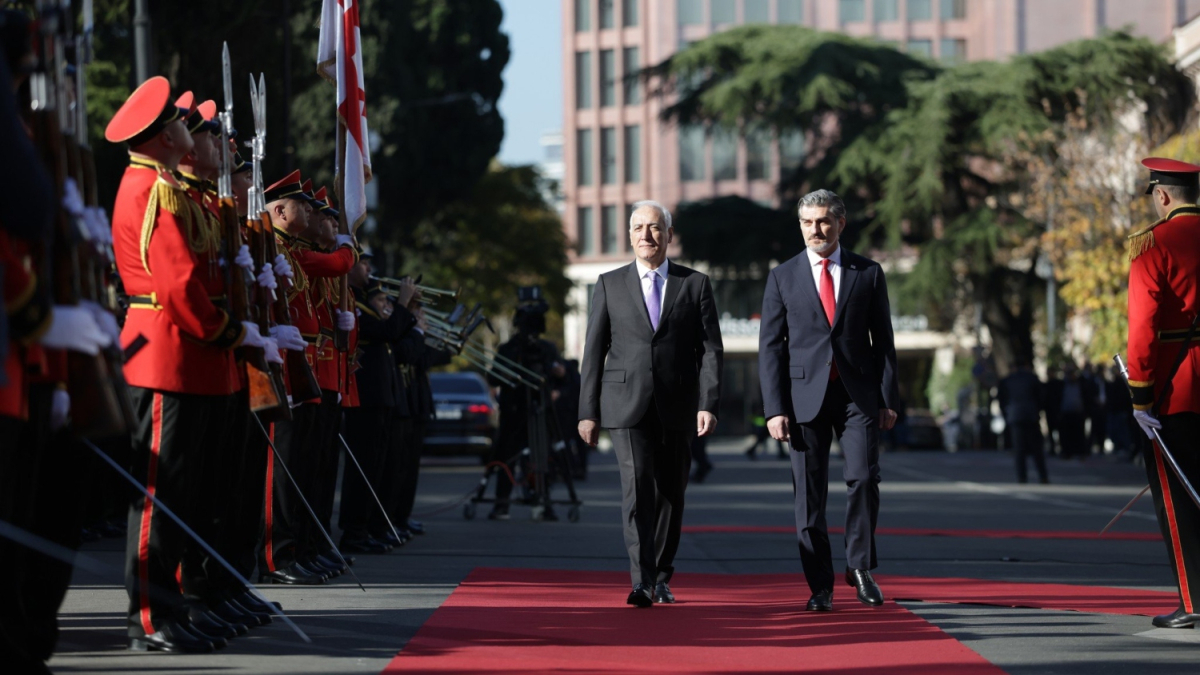Afghanistan Pakistan clash: Iran sets date for mediation meeting
Iran is preparing to host a multilateral regional meeting next week in a bid to mediate between Afghanistan and Pakistan....

Armenian President Vahagn Khachaturian’s official visit to Georgia is testimony to a rapidly strengthening partnership between the two neighbouring state following the initialling of the Armenia–Azerbaijan peace agreement.
Khachaturian was received at Tbilisi International Airport by Georgia’s Foreign Minister Maka Bochorishvili and other senior officials, before heading to the Presidential Palace for an official welcoming ceremony and face-to-face talks with Georgian President Mikheil Kavelashvili.
The visit, marked by ceremonial honors and a series of high-level meetings in Tbilisi, signals that 2025 may become a pivotal year for South Caucasus diplomacy.
The Armenian leader is set to meet with Prime Minister Irakli Kobakhidze and Parliament Speaker Shalva Papuashvili as part of the visit.
Kavelashvili in a statement thought back to the centuries old relationship between both countries. He also welcomed the Armenia – Azerbaijan peace agreement stating that Georgia was ever ready to promote peace in the region.
“I emphasised that the peace agreement reached between Armenia and Azerbaijan on 8 August in Washington represents a significant step forward in ensuring sustainable peace and a stable environment, and we naturally welcome it.”
At the joint briefing, both presidents emphasised the centuries-long foundations of Georgia–Armenia ties, describing them as rooted not merely in geography, but in shared values: state sovereignty, national identity, and cultural diversity.
President Kavelashvili noted that the relationship has become “exemplary” in multilateral cooperation, highlighting Armenia’s consistent support for Georgia’s territorial integrity as a cornerstone of trust between the two countries.
Khachaturian echoed this sentiment, stressing that the historically strategic nature of the relationship has now been given “official form” through expanded cooperation frameworks.
In a post on his X account, Khachaturian highlighted the “crossroads of peace” initiative and its reflection on regional trade and interconnection.
Discussions covered an array of sectors—economic development, cultural exchange, education, and youth initiatives—with both leaders expressing commitment to broadening joint projects in the months ahead.

This second bilateral meeting in less than a year signifies an accelerated diplomatic tempo. According to analysts, this momentum reflects a new urgency brought on by shifting geopolitical currents and the prospects of long-awaited regional stability.
Central to the leaders’ discussions was the Armenia–Azerbaijan peace agreement, initialed earlier this year. Georgia has publicly welcomed the deal, framing it as a critical step toward long-term regional calm. Both Kavelashvili and Khachaturian shared confidence that a sustained peace could unlock transformative economic opportunities.
A New Logistics Geography in the Making
One of the strongest messages from both sides was the belief that peace between Armenia and Azerbaijan could turn the South Caucasus into a major logistics corridor, connecting markets across Europe, the Middle East, and Asia. Georgia and Armenia—positioned at the crossroads of these potential routes—stand to benefit significantly if stability is assured.
Such a development would reshape trade dynamics, reduce transit vulnerabilities, and strengthen the region’s role in global supply chains. For Georgia, this could reinforce its status as a key transit hub; for Armenia, it presents opportunities to reorient its economy toward broader regional integration.
Khachaturian’s meetings also touched on upcoming international conferences, including Armenia’s preparations for the Seventeenth Conference of the Vital Convention and the Eighth European Civil Forum, signaling Yerevan’s intent to deepen cooperation on multilateral platforms with Georgia.
While the tone of the visit has been warm and forward-looking, analysts note that the next steps will depend on both security conditions and the speed of the Armenia–Azerbaijan peace process. Still, the diplomatic signals are clear: Tbilisi and Yerevan are preparing for a new chapter—one that blends strategic alignment with practical economic ambitions.
As Khachaturian continues his engagements in Georgia, the visit reinforces what both sides have increasingly articulated: the South Caucasus is entering a period of cautious hope, and Georgia–Armenia cooperation is positioned to become one of its stabilising pillars.
Scores of demonstrators gathered outside the Norwegian Nobel Institute in Oslo Tuesday (9 December) to protest against the awarding of this year’s Nobel Peace Prize to Venezuelan opposition leader Maria Corina Machado.
Iran and Saudi Arabia reiterated their commitment to enhance ties following a joint meeting with China in Tehran on Tuesday to follow up on implementation of the 2023 Beijing Agreement which resulted in resumption of their diplomatic relations after eight years.
The world’s leading minds and voices will be honoured on Wednesday, 10 December, the anniversary of Alfred Nobel’s death, as Nobel Prizes are presented in Stockholm and Oslo.
In a dramatic Champions League clash at Baku’s Tofiq Bahramov Stadium, Qarabağ grabbed an early lead, but Ajax staged a thrilling comeback to win 4-2.
Ukraine "deeply appreciates" the humanitarian support of Pope Leo XIV. This was stated by Ukrainian President Volodymyr Zelenskyy after a meeting between the two at the papal residence of Castel Gandolfo, on Tuesday, 9 December.
Iran is preparing to host a multilateral regional meeting next week in a bid to mediate between Afghanistan and Pakistan.
Baku and Budapest strengthen diplomatic relations as Azerbaijan’s Foreign Minister, Jeyhun Bayramov, began a working visit to Hungary on, Wednesday, 10 December.
The Asian Development Bank (ADB) has revised its outlook for the economies of Central Asia and the Caucasus by raising its growth forecast for 2026
Iran's President Massoud Pezeshkian has begun a two day visit to Kazakhstan, with officials from both sides describing the trip as an opportunity to advance cooperation in trade, transport, industry, mining and cultural exchanges.
Uzbekistan will introduce a nationwide system to assess the resilience of officials and civil service candidates to corruption risks from 2026, according to a presidential decree adopted this week.
You can download the AnewZ application from Play Store and the App Store.

What is your opinion on this topic?
Leave the first comment